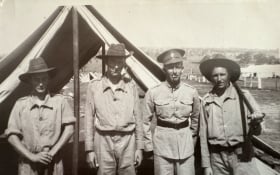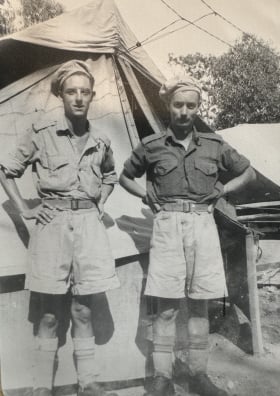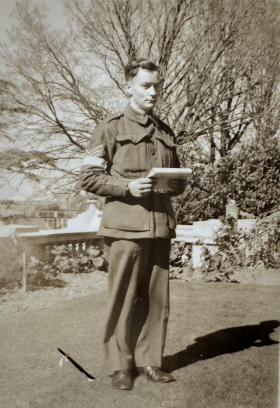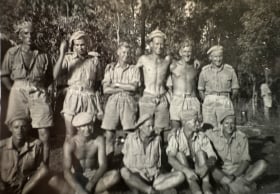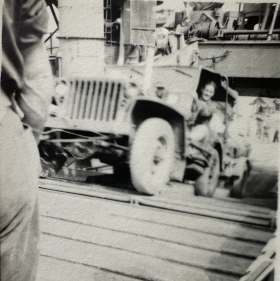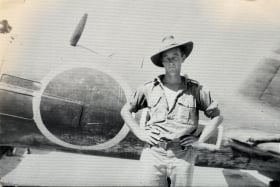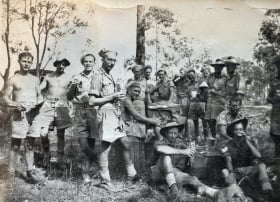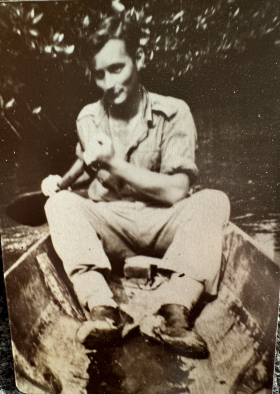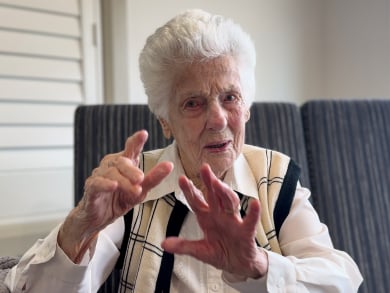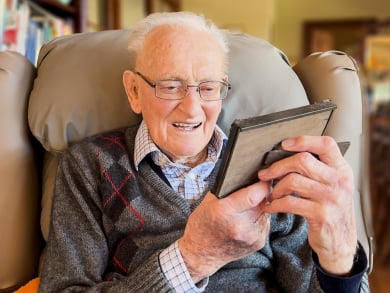You might be one of
Australia's oldest
uses of the computer, actually,
if not the oldest.
What do you use your computer for?
Nothing special.
Just normally use it
for contacting people
or looking up bank accounts,
all that sort of thing., General purpose.
It's a general purpose.
Probably 101st.
That’s 105th birthday.
My name is Colin Lens Wagner.
And I was born in Adelaide,
December 2nd, 1917.
In those years,
the parents named their children
after a battle of World War One.
So I was called Lens.
L-E-N-S. .
Colin Lens Wagner.
My parents were very hard working.
They had a shop
and they had a machine shop
and they had a bicycle shop.
His name was William Wagner
and he tried everything to make money.
He was a hard worker.
Well you see, after the First World War,
when the soldiers came back,
they had brought a broader sensitivity,
get things done.
I had two sisters.
I got on alright with them.
They were about ten years old than me.
I was a late one starter.
But,
one was a wild one
and she was an icon of the Roaring 20s.
She drove
my parents up the wall
with all those carryings on.
I do remember the
opening of Canberra in 1927.
I have an official invitation to there,
to the opening of parliament house.
My parents took me there in a car,
in a 1925 Studebaker.
It was very difficult.
We had to go through the Coorong.
The Coorong didn't have any
roads properly then.
Just track.
Down to Mount Gambia
and across the mountain range to
Canberra.
There couldn’t have been too many camping
in Canberra, in the caravan park,
because one water tap did everybody.
Did the lot.
The tap was frozen over
until about 9:00 in the morning,
so they must have been cold nights.
And all the supplies
we had to get were from Queanbeyan.
There was nothing open in Canberra
They were still building it.
They were getting
official buildings done.
Parliament House,
they just got that done in time.
My parents,
I remember, them
saying to me, we’re taking you so you’ll
remember to tell it in years to come.
And here I am telling
it in years to come.
I remember the opening.
All the guards were there
for the opening, in three rows.
And one of them feinted
and nobody knew
anything about it for a while
until they got him out of it.
So I guess they were
World War I soldiers
being re-used again.
Three planes flew overhead.
I heard one of them crashed
and the pilot was killed.
My father took me to see
the wreckage of the plane.
It looked,
quite simple.
Nothing much of it.
It was enough to kill somebody.
Twin winged planes.
I just remember those little bits
about it.
This radio was built
in 1924 for my father.
It was his first wireless set
and I’ve still got it.
And it still works.
And it was from this set
that I became interested in radios.
That's a crystal detector for it.
And these are coils so you
can get different stations.
It's quite a primitive set
but there's two valves.
You can see the valves in there.
They amplify the signals that come in.
It’s from there
that I made my own radio sets.
I reckon about eight or nine
years of age.
And I got books from,
you know, magazines from England.
And they had crystal sets.
The boys magazines in England.
And I made a crystal set
and I made a one valve set
and a two valve set. All shortwave.
And I'd be in my room
with earphones on until about one
or two o’clock in the morning
listening to overseas stations.
And I think it cost them 15 pound.
It was a hell of a lot of money.
Price of a push bike.
My father had a shop down on
Glen Osmond Rd.
It was close to Parkside
and it had a big garage door on the front
which he opened up
and there was a radio in it
- a seven valve all wave super heterodyne
with a big speaker on it.
And a lot of people
used to come along with their chairs
and listen to the radio
until about 2:00 in the morning.
That was the cricket in England
that they would listen to. Parkside.
This was during the Depression.
But the interesting part
about that radio, it was made by me.
And I was about 14 at the time.
The day I turned 16,
I went into the Register of Motor Vehicles
and got a license to
ride a car or drive a motor vehicle.
And my parents gave me a motorbike.
A secondhand one.
And I rode it to school
and all my school mates
were looking at the beautiful chrome tank.
They thought how lovely it was.
But the headmaster had other ideas.
He was from the horse and buggy stage
and he told me never to bring it
near the school again.
That was the end of that.
I didn't.
During that bit
between the Great Depression
and the start of World War II,
I wanted a sports car,
and they were unobtainable.
So the only thing to do
was for me to make one.
Which I did.
I made a sports car.
With a lot of help from professionals.
It would have been cheaper
if my parents had gone and bought me one.
If they could have.
Four us
sort of come together
because very, very few
people had motor cars,
particularly young kids.
It was very rare to have a sports car.
And we sort of found one another
and the four of us made friends.
And we all joined the Army together.
Saw it coming.
We reckon, we go to them
before they came and got us.
That’s about what it amounted to.
We joined the Army signals.
there was vacancies for signalers.
And we just went in
part time until 1939.
And then when the war started,
we went in full time.
One was killed in the Middle East
with a bomb.
The second one died as a P.O.W.
in Singapore.
And Steve Tillet,
he picked up a bullet in New Guinea
and he was flown back to Australia
more dead than alive
but he survived and he got better again.
So really two of us survived.
Just luck.
You’ve either got it or you haven't got it.
Yes, I was sent
to Woodside Military Camp.
And from there I was sent to Loveday.
I had a good background of radio.
Knew all about it.
They wanted to establish a radio link
between Darwin and Adelaide.
And I did.
Then I rigged up another aerial
to see if I could get Adelaide, and I did.
So we
we had a very precarious radio link
between Darwin and Adelaide.
And they said, “From now
on, you’re an instructor”.
I said, “I don't know
anything about instructing”.
They said,
“Well you’ve got three stripes,
go out and earn them.”
So that was the end of that.
When you're in the Army,
you just walk along a tightrope
and you don't fall off.
You do exactly what they tell you to do.
So that was 8:00 in the morning.
And I said,
“Can I have four hours leave?”
And they said, “Yes,
you have leave till 12:00”.
And I raced around and got my
future-to-be wife.
She was from Menindie,
up on the Darling River.
Yeah, well I met her because
I was one of the very,
very few young kids who had a motor car.
We were fair game.
I said, “Shall we get married,
we’ve got four hours to do it?”
[Before] I get back to camp.
So in those four hours we
went and got married
and I got back to camp.
And then I went off to Bonegilla to
establish the Number One Signal Training.
I did it if for about 12 or 18 months.
because of my qualifications
being an instructor,
I was sent to the
signal office in Townsville.
And it was run by girls, about 15.
AWAS they were.
Australian Women’s Army Service.
They were all good.
I had ten days leave
I came home in that ten days.
I bought a house at St Georges
and that provided Peggy with
a roof over her head.
Yes, I joined a unit then.
An operational unit.
The 2/3rd Anti-aircraft Regiment.
And we were attached to the 9th Division.
We were classed as a
defensive unit, not an offensive unit.
An offensive unit is infantry.
You go out looking for trouble.
A defensive unit is us.
Let trouble come to us.
We were supplying all the communications.
We headed [off] on a troop ship.
There was about 2,000 on it.
We played chess all the way to Morotai.
It was very hot.
We were just with
no shirts on.
I took some photos
of being on board
the ship along the way to
Borneo.
And then another chap took our photo,
just myself and the four drivers.
Now that’s a photo of us on the LST.
Just before we did the
the landing.
That's me.
That's our four drivers.
He said, “I want to take your photo.”
So we found out after.
He said, “I took your photo
just it case you didn’t make it
on the landing.”
But we did.
There wasn't any harbour there.
To get off the boat,
they threw rope
ladders over the side of the boat.
We saw some LSTs or ‘Landing Ship Tanks’
coming in.
Ready to come in one at a time
and we knew they’d be for us.
Rope ladders over the side,
we got on the boats.
But the LSTs,
all went in.
We unloaded
and there’s a photograph of me
coming off.
It must’ve been pretty late
because we couldn't get off the beach
and we just held the landing that night.
We expected
air raids or something
but it never happened.
I had a cheap camera with me.
If I’d had an expensive one
it would have got pinched.
I had a cheap one
and another chap in the unit also
had a cheap one.
Similar cameras
and he knew more than I did
about developing films.
And he said, well,
if you go to the up to the RAAF,
their reconnaissance unit,
that's the ones that take photographs from the air.
Air photographs.
He said they've got some material.
Here's what to get.
And he said it'll take
at least 30 cigarettes to get them.
I received a cigarette ration
and that gave me cigarettes,
which were very handy to me.
Ten cigarettes I used to buy an egg with,
but the rest I used to get photography with.
So it went over
with a handful of cigarettes
and put them down on the table.
I got it
and we came back
and we developed the films at night time.
It had to be completely dark
and we made a torch
with a red rag over it
to see what we were doing.
If anybody had turned a light on
at the wrong time,
we would have lost everything.
But they didn’t.
And we developed films.
You know, a 'jungle developing
company’ sort of thing.
And got away with it.
We did it.
And it was at that point there
I thought the war would never end.
I’d been in it for six years
and the war was just going on and on.
And then
the atom bomb dropped and
war suddenly came to an end.
I found out on the grape vine.
Yeah I was just pleased that I’d made it.
But then, of course, came the big thing,
the surrender.
We'd found out that there was a death march
2000 Australians were murdered,
and we wanted to round up
the people who did it.
And we did.
Sandakan was not far away
from where we were at Labuan.
And that was where the death
marches started from.
Most of the garrison from Sandakan
had gone inland to Ranau.
They murdered them along the way.
Someone had to go and pick up
the remnants,
what was left of the garrison,
at Sandakan.
We sent an LST,
a Landing Ship Tank, over.
And one of our group, a corporal -
he was a very good corporal -
I gave him my gun.
It was a machine gun.
I said, “If you use it, clean it”.
They pulled into the harbour
at Sandakan.
The Japanese,
they were all on the wharf waiting.
There was half a dozen wooden boxes.
They were quite heavy.
About the size
you could lift one up
and put on your shoulder and carry along.
They had Yokohama Specie
Bank written on them.
We knew they were full of money.
So the corporal went in and
saw this Japanese chap in the tent.
He was sitting at a table,
the boxes along side of him,
and he was waiting to be greeted
by the corporal.
The corporal walked in the tent,
pointed a gun at him and said,
“Get out and join the others!”
And they were all put on the boat.
On the way back,
they were put in [the] charge
of a private
and the private had other ideas.
He told them to put their packs on
and they put their packs on
and he formed them into a ring
and he made them run at the double
around and around the ring in the heat.
I don't know how long it went on for,
but an officer came down,
saw it and stopped it.
So that was
as close as they got to a death march.
It wasn't very much at all.
They arrived at the back of Labuan
and I was there with my camera.
I took a photograph
on the deck of the ship.
Another couple of photographs of them
walking along.
They were very obedient.
They didn't play up at all.
We opened the boxes.
It was Japanese invasion money
and as the Japanese had lost,
the money was worthless.
The boys made a big pile of them.
I must have had an honest face
because I was given the job
of burning it.
I had to get a long stick
and it was like burning phonebooks.
And the next morning
it was just a pile of red ashes.
A few years ago,
I looked on the computer,
and I saw the 9th Division
had given their version of the surrender.
And it was whitewashed.
It was never correct.
So I was speaking at a meeting
and I gave the real version.
The Canberra War Memorial checked on me.
They said yours was different from ours.
Can you prove it?
I said, “Yes I can.”
So I had photos to prove it.
So here is the real story
of the surrender.
Baba. General Baba.
B-A-B-A.
He was a war criminal
and we wanted him dealt with.
I was standing there
and I saw the plane come over the top.
I was very pleased to see it
and it landed.
I was there with my camera.
But there was an official
camera standing by.
I just thought what a bugger he was.
I couldn't...
you know, there's not much you could do
[as an] individual.
You just.
You just look at them as...
You just don't like them.
General Baba was told to come on a plane
and sign a surrender document.
And they had to put white crosses
over the red rondelles
so we’d know what plane it was.
But to me that was not the case,
the white crosses were to humiliate him.
That was first sign of humiliation.
And it was one of our jeeps
that took the general
to the surrender point.
I was told
he was told to get in the jeep.
Standing alongside him was a big chap,
with 'MP’ on the side...
He was a private.
The general being a general [would] naturally
sat in the front seat of the car.
The private told him to
go get in the back.
This is the unofficial version that I'm giving.
And you can see the
private sat in the front seat.
And you can see
it's real
because the general
is sitting in the back seat.
I spoke to the driver afterwards.
I never used that particular driver.
He said he took him as fast
as he could over every bump he could.
The next two photos
of the general going into the hut
to sign the surrender document.
What our side,
I did,
was to put a mortar gun
right alongside of the hut.
Hard up against it.
And he wasn’t to know about it.
So they marched him in there
and the next photo is taken officially.
You see him signing a surrender document,
and as he signed it,
about to put the pen down,
a signal was given at the door
and the gun went off and
the hut shook very badly.
And I think it didn't do him
any good at all.
A couple of hours later I saw him again.
He was in a hut.
Ordinary tent.
Usual furniture -
a long table and two long chairs.
He was sitting on a form
with his back to me
and there were two lieutenants
standing each side of him.
Each of them had a foot up on the
form alongside of him
and one was pointing his finger at him
and he was saying to him,
“Who told you to lock up civilians?”
And I saw the general just...
He was still in a state of shell shock.
He didn't know...
After that,
they put him into a compound.
The compound the Japanese made.
I saw two or three of them.
They were just four posts in the ground.
Probably about three meters by three meters.
Wire netting up the side,
and
they put our troops in them overnight.
What he was finding out
first hand, what it was like,
he was put in one.
It was all unofficial.
If it rained, he got wet.
All the mosquitoes
bothered him all night.
He wanted to commit suicide,
but we wouldn't let him.
We put a guard there
on a hut.
Guard him all over night.
We put two lights on the thing
to watch him
to make sure he didn't commit suicide.
I had to be very careful
because there were a couple of shots
I would have liked to have got,
but I wasn't game to take.
That would have been the
the general sitting in
in the pen.
I'd love to have taken the photograph
but I just wasn’t game.
I thought I might...
I’d better not.
He survived to be tried and he was hung,
but that that was not my story.
That's someone else’s.
It was the plane
that General Baba came in.
It was sitting there doing,
you know, surplus sort of thing
and a few of the RAAF boys,
air pilots, were basically
waiting for us to get back to Australia
on leave.
So they filled a plane up with pilots
and they flew it back to Australia.
That's how they got home.
It's all unofficial.
And they left it on an airstrip
and forgot about it.
A few years ago,
the Australian War Memorial
in Canberra found the plane,
and somehow or other
they got it back to Canberra.
Probably by road of course.
And they’re restoring it.
It's going to be an exhibit.
We had to wait [for]
a ship to bring us in.
We waited and waited and waited.
We were very frustrated.
And we waited right down to December
the 10th, 1945.
At that stage
I'd walked over to the airstrip
with a handful of cigarettes
to get some more material
to do some more photos.
I heard the engine of a plane start up,
then rev up.
I heard it go down the runway
and I heard the engines suddenly stop
and there was an enormous bang.
The plane had crashed.
Of course we all raced out
and the plane had gone into a ditch.
Everybody on board was killed instantly.
But they seemed to be lying around
just on the side of the plane.
It was that intense.
In about 20 minutes they were all ashes.
You couldn't tell who they were.
But I photographed it.
At that moment,
one of our chaps
from the main unit came in.
He said, “Come back straight away.
Two ships are coming to take us home!”
It was at that point of my war career,
that I had a tragedy on one side and
I had good news on the other.
I felt for the people
who were going to receive
some bad news in Australia,
and I just received good news.
I went down, two Victory ships
had come in, to take us home.
I thought it might be a change of ration,
but it was worse.
There was no...
they were just cargo ships.
1,500 of us
got onto each ship,
and we...
There was nowhere to eat,
nowhere to sleep. We couldn't care less.
We were going home.
And it was wonderful to
go down the Brisbane River.
We thought after two months,
2 or 3 months
after the war,
Australia would have forgotten about us,
but they hadn’t.
It was the 9th division coming home.
The last one.
As we went past the ships in the river,
they fired their fire hoses into the air
welcoming us home.
There was a troop train
standing by
to take us home,
but the people of Brisbane
had other ideas for us.
They loaded us into trucks
and they drove us slowly down
the main street of Brisbane
to a ticker tape welcome home.
I felt little bits of paper
falling on me.
We were wet from a shower of rain.
We were dirty.
We were hungry.
But we didn't care.
We were going home.
And my next thing is
I got
the best Christmas present
I ever got in my life.
It was half past ten
Christmas morning,
1945,
when a train pulled
into Adelaide Railway Station
and I was on it.
My father picked me up
and brought me home.
It was a wonderful feeling
to walk up to my front door
knowing I would
never have to go away again.




